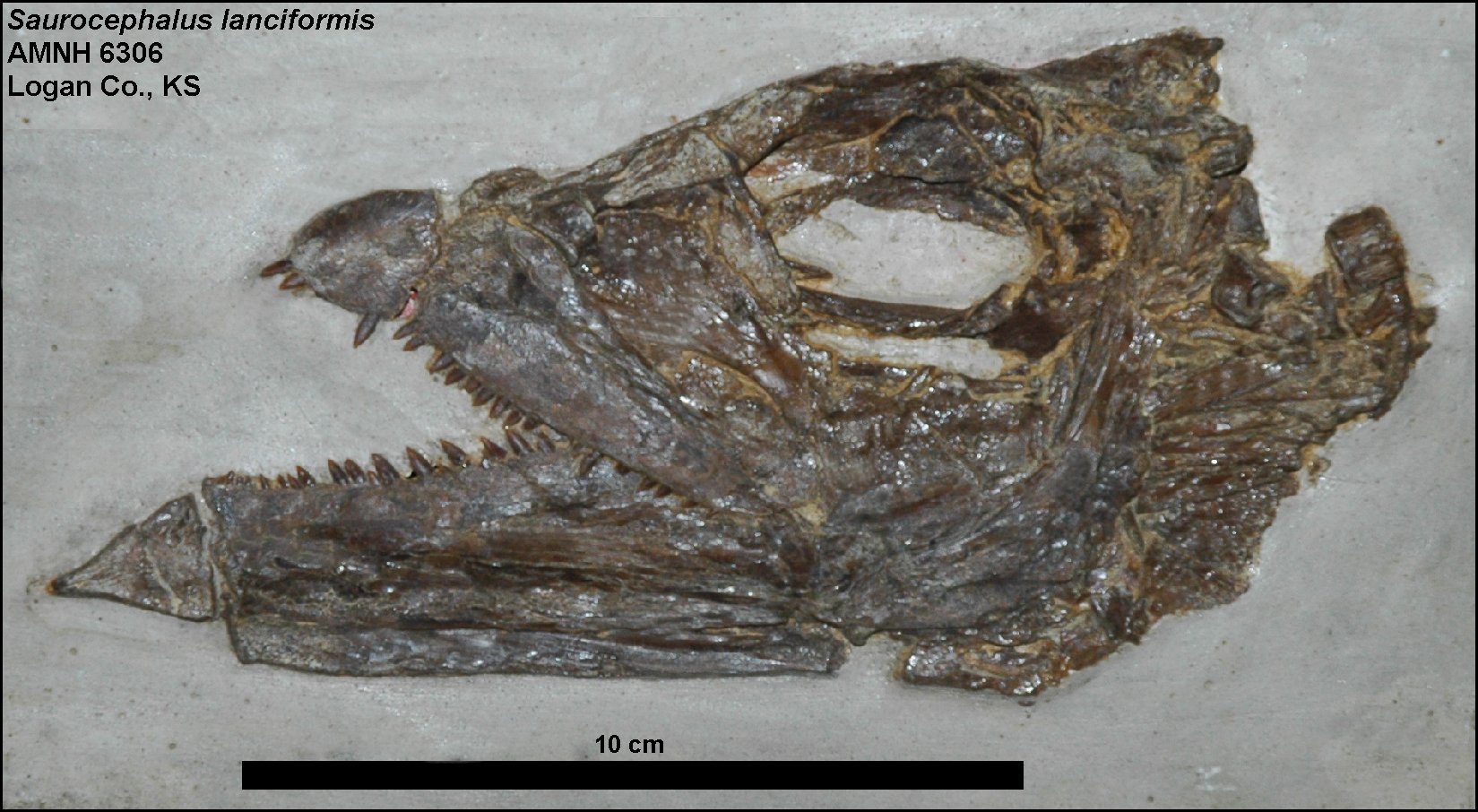Post by Infinity Blade on Jan 23, 2016 10:21:01 GMT 5
Saurocephalus lanciformis

Skull of Saurocephalus.
Temporal range: Late Cretaceous (Early Campanian [1] to Maastrichtian[2])
Scientific classification:
Life
Domain: Eukaryota
(unranked): Unikonta
(unranked): Opisthokonta
(unranked): Holozoa
(unranked): Filozoa
Kingdom: Animalia
Subkingdom: Eumetazoa
(unranked): Bilateria
Clade: Nephrozoa
Superphylum: Deuterostomia
Phylum: Chordata
Clade: Olfactores
Clade: Craniata
Subphylum: Vertebrata
Infraphylum: Gnathostomata
Clade: Eugnathostomata
Clade: Teleostomi
Clade: Euteleostomi
Class: Actinopterygii
Order: †Ichthyodectiformes
Family: †Saurodontidae
Subfamily: †Saurodontinae
Genus: †Saurocephalus
Species: †S. lanciformis
†S. woodwardii?
Saurocephalus ("lizard head") is a genus of ichthyodectiform actinopterygian that lived in the Western Interior Seaway and the type Maastrichtian from the Early Campanian[1] to the Maastrichtian.[2]
Description and paleobiology:
Saurocephalus was a large (2-3 meter long[1]) elongate predatory actinopterygian like its relatives Saurodon and Prosaurodon.[1] Its most notable and unusual feature was arguably is its pointed pre-dentary bone that projected forward (like in other saurodontids). It is said that the function of such a structure is unknown[1]. There was at least one proposal that it could be used as an offensive weapon[3], although if such was the case, then it should be noted that, upon direct observation, the pre-dentary of Saurocephalus seems to have been shorter and blunter than that of its relative Saurodon.

Skull of Saurodon. See the skull of Saurocephalus shown earlier for comparison of the pre-dentary bones.
The vertebrae were cylindrical, as wide as they were long. Each centrum's lateral surface had two large elliptical pits.[2]
The teeth were low crowned and triangular with serrated bicarinae on each tooth. The roots were particularly long. The teeth were also closely spaced and gradually became larger as they went back further in the mandible.[2] There was only a single dental row in the jaws.[1] It can be reasonably inferred that Saurocephalus' jaw apparatus relied on the sharpness of its teeth to dispatch prey via slicing while likely relying on some degree of jaw power given how well rooted the teeth were.
References:
[1] oceansofkansas.com/saurodon.html
[2] "Ray-finned fishes (Osteichthyes, Actinopterygii) from the type Maastrichtian, the Netherlands and Belgium" (Friedman, 2012).
[3] Reports, Volume 6 (Kansas Geological Survey, p. 310, 1900).

Skull of Saurocephalus.
Temporal range: Late Cretaceous (Early Campanian [1] to Maastrichtian[2])
Scientific classification:
Life
Domain: Eukaryota
(unranked): Unikonta
(unranked): Opisthokonta
(unranked): Holozoa
(unranked): Filozoa
Kingdom: Animalia
Subkingdom: Eumetazoa
(unranked): Bilateria
Clade: Nephrozoa
Superphylum: Deuterostomia
Phylum: Chordata
Clade: Olfactores
Clade: Craniata
Subphylum: Vertebrata
Infraphylum: Gnathostomata
Clade: Eugnathostomata
Clade: Teleostomi
Clade: Euteleostomi
Class: Actinopterygii
Order: †Ichthyodectiformes
Family: †Saurodontidae
Subfamily: †Saurodontinae
Genus: †Saurocephalus
Species: †S. lanciformis
†S. woodwardii?
Saurocephalus ("lizard head") is a genus of ichthyodectiform actinopterygian that lived in the Western Interior Seaway and the type Maastrichtian from the Early Campanian[1] to the Maastrichtian.[2]
Description and paleobiology:
Saurocephalus was a large (2-3 meter long[1]) elongate predatory actinopterygian like its relatives Saurodon and Prosaurodon.[1] Its most notable and unusual feature was arguably is its pointed pre-dentary bone that projected forward (like in other saurodontids). It is said that the function of such a structure is unknown[1]. There was at least one proposal that it could be used as an offensive weapon[3], although if such was the case, then it should be noted that, upon direct observation, the pre-dentary of Saurocephalus seems to have been shorter and blunter than that of its relative Saurodon.

Skull of Saurodon. See the skull of Saurocephalus shown earlier for comparison of the pre-dentary bones.
The vertebrae were cylindrical, as wide as they were long. Each centrum's lateral surface had two large elliptical pits.[2]
The teeth were low crowned and triangular with serrated bicarinae on each tooth. The roots were particularly long. The teeth were also closely spaced and gradually became larger as they went back further in the mandible.[2] There was only a single dental row in the jaws.[1] It can be reasonably inferred that Saurocephalus' jaw apparatus relied on the sharpness of its teeth to dispatch prey via slicing while likely relying on some degree of jaw power given how well rooted the teeth were.
References:
[1] oceansofkansas.com/saurodon.html
[2] "Ray-finned fishes (Osteichthyes, Actinopterygii) from the type Maastrichtian, the Netherlands and Belgium" (Friedman, 2012).
[3] Reports, Volume 6 (Kansas Geological Survey, p. 310, 1900).



